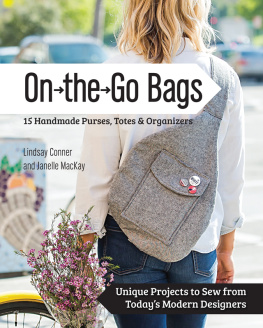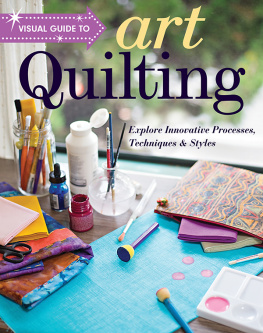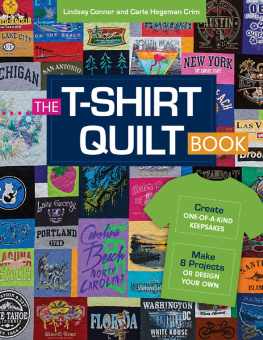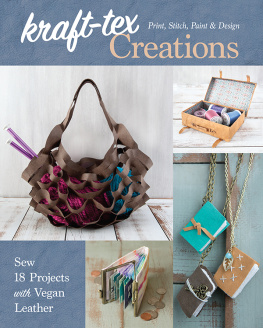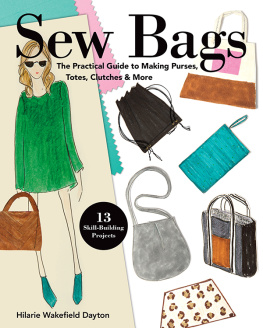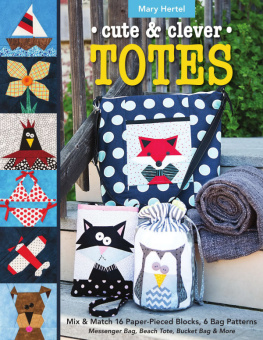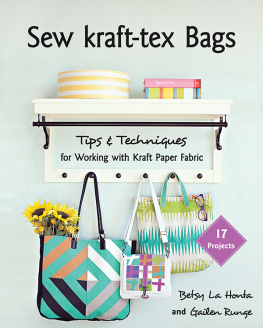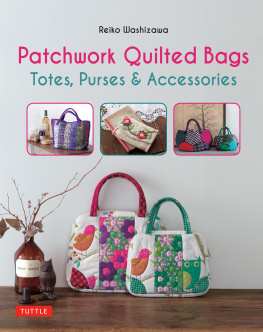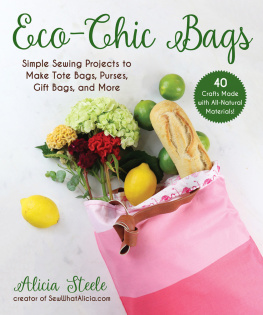Publisher: Amy Marson
Creative Director: Gailen Runge
Art Director / Cover Designer: Kristy Zacharias
Editor: Liz Aneloski
Technical Editors: Debbie Rodgers and Amanda Siegfried
Book Designer: April Mostek
Production Coordinators: Jenny Davis and Freesia Pearson Blizard
Production Editor: Alice Mace Nakanishi
Illustrator: Aliza Shalit
Photo Assistants: Mary Peyton Peppo and Sarah Frost
Style photography by Nissa Brehmer and instructional photography by Diane Pedersen, unless otherwise noted
Published by Stash Books, an imprint of C&T Publishing, Inc., P.O. Box 1456, Lafayette, CA 94549
Dedication
Thank you to all the people in my life whove graciously allowed me the time, space, and freedom to create. My husband, Matt, is my biggest fan and the instigator behind all my best ideas. My parents have fielded numerous frantic phone calls and loved every minute of grandparenting. And little Elliotwho has watched me lose my cell phone, wallet, keys, and groceriesthank you for making me realize that I need a better bag to hold all your junk. I love you.
Lindsay
This book is dedicated to my dear mom, who, when I was young, encouraged me to use my hands and heart to create things that I could love making and be proud of. She taught me to knit, crochet, embroider, cross-stitch, and best of all, to use a sewing machine. This book is also dedicated to my amazing husband, for all his support and encouragement. Mike, thank you for putting up with all my creative messes, and I owe you an apology for not paying attention when my mom was teaching me to cook.
Janelle
Acknowledgments
First of all, thank you to the publishing team at C&T for believing in us and spending countless hours turning this project into a bound book. It has been a pleasure to work with our book team: Liz Aneloski, Debbie Rodgers, Amanda Siegfried, Kristy Zacharias, April Mostek, Jenny Davis, Freesia Pearson Blizard, and Alice Mace Nakanishi. Without the creativity and dedication of our amazing contributors, this book would not be possible. We also thank our meticulous pattern testers and designers: Kate Alicea, Jennifer Bryant, Betty Canfield, Natalie Cox, Candis Gengler, Cindy Guch, Sue Kim, Tracey Lipman, Gwen Lockwood, Katie Mehta, Laurel Notturno, Jenny Parker, Angela Pingel, Marcia Reel, Lindsey Rion, Jennifer Savelio, Simone Symonds, Maria A. Vazquez, and Nicole Young. Last but not least, thank you to Baby Lock sewing machines and to all the companies who supported this project by generously providing materials to bring our designs to life (see Resources).
Introduction
Does it feel like you always have somewhere to be? Whether youre packing for vacation, dropping off the kids at school, or running a quick errand on the way to work, your life is in a constant state of motion.
Your story is like all of ours. Its a story of learning to breathe in the midst of a crazy day. Its a story of losing your cell phone, and of watching the shopping cart roll down the parking lot while you dig for your keys.
But its also a story of making, learning, and growing. Its about the innate feeling of accomplishment when someone sees your bag and asks, Did you make that? Its the sense of mastery that comes with sewing your own bags, fulfilling your human desire to create.
Flip through these pages and youll discover fifteen innovative patterns for bags and organizers to make life easier when youre on the go. Your favorite bag designers and popular bloggers have contributed unique, handmade organizers for specific purposes, from protecting your iPad to changing purses in an instant. Beyond the basic tote or zippered pouch, youll learn to make several styles of pockets and straps; install purse hardware, zippers, elastic, and cording; apply interfacing and stabilizers; and pair designer fabrics with unusual materials like vinyl and mesh.
Start with one of the beginner-friendly patterns, and then challenge yourself with an intermediate or advanced bag. Youll learn to sew stylish bags and organizers that will do more than just look pretty on a shelftheyll actually make your life easier!
As an added bonus, youll see that most bags in this book have dual purposes, making them incredibly versatile and practical to sew. For instance, a coupon organizer not only straps onto the grocery cart but also hooks onto the stroller to carry a childs drink and snack (see Cart or Stroller Caddy).
Work through the projects and youll gain confidence in your technique, as you sew useful and really unique bags and organizers to fit your on-the-go lifestyle. We hope each bag also helps you nurture your inner maker, allowing you a moment to grow into your creative self.
With each stitch, we wish you a retreat from your crazy life. Theres always somewhere you have to be. But wherever you are coming from or going to, your handmade bag can go with you. Its a gentle reminder that you are creative, accomplished, and uniquely you. Happy travels, and happy sewing!
Techniques
Cutting with a Rotary Cutter
This book includes both pullout pattern pages and rotary cutting instructions. Rotary cutting instructions allow bag makers to use fast and accurate cutting skills, which yield fabric pieces with straight, square, and precise edges. For some traditional bag makers, this method can be a daunting task if they are unfamiliar with it, but after using the rotary cutting instructions, most bag makers decide they love the precision, accuracy, and professional results. You can cut several layers at a time with no drawing or template making required. When you are rotary cutting, make sure you cut your rectangles on the straight grain of the fabric and label all your pieces.
Pattern Pieces
Some of the projects in this book refer to pattern pieces that are included on the two-sided pullout pattern page at the end of the book. These pattern pieces are full size and include seam allowances. Make your own pattern pieces by tracing your required piece onto tracing paper, template plastic, or lightweight interfacing. You could also use dressmakers carbon paper and a tracing wheel to transfer the cutting lines onto fabric. Remember to cut all the notches and transfer all the placement markings.
Curved Corners
Some rectangular fabric pieces will require curved corners, so we have provided a set of corner patterns. Although you may choose to eyeball your curves and cut them freehand with a rotary cutter, you may wish to trace the required corner pattern onto a piece of paper or template plastic before rounding the corners of your fabric. To use corner templates, place the curved template on the corner of the fabric piece and trace with a pen and cut, or simply cut along the curve with your rotary cutter. Flip the template over and repeat for the opposite corner.
Tip 
To save time, grab a cup or saucer from the kitchen and try the curve of the top rim on the required template to find a size that matches.
Fusible Interfacings, Fleece, and Stabilizers
Always refer to the manufacturers directions to attach any fusible interfacings, stabilizers, or fleece, but here are a few key tricks and tips to make the process go smoothly.
Select interfacing that is appropriate for the weight of the fabric you are using. Use light- to medium-weight interfacing for light- to medium-weight fabrics, and medium- to heavyweight interfacing for medium- to heavyweight fabrics. A heavyweight interfacing on a lightweight fabric will create a stiff, papery fabric thats prone to creases and bubbles. A very lightweight interfacing will not be a great help to heavier fabrics. Woven interfacing is a bag makers favorite because it provides structure to the fabric and doesnt feel stiff and crinkly.
Next page
